Uvalde, Texas
CNN
—
Uvalde County Sheriff Ruben Nolasco rushed toward Robb Elementary School when calls came in that a man was firing his gun after crashing his pickup truck on May 24.
He was one of the 376 officers who went to help children and teachers. But, unlike the vast majority, he had the rank to easily take charge, he had vital information about the shooter and a call about victims in a classroom, and others looked to him as a commander on the scene with up-to-date information.
But despite more than 30 years of law enforcement experience for the city and county, despite knowing not only his own staff but many in the command structures in the multiple agencies that arrived at Robb, Nolasco chose to stay at a different crime scene, already under control, as a far greater disaster initially unfolded. He did not take charge when he did arrive and did not ensure that cries for help from girls trapped with injured classmates and teachers were acted on.
In the days after the massacre that killed 19 children and two teachers, as demands rose for answers to why it took 77 minutes to stop the gunman once he got into the school, Nolasco was comforted by Texas Gov. Greg Abbott and US Sen. Ted Cruz, his political allies.
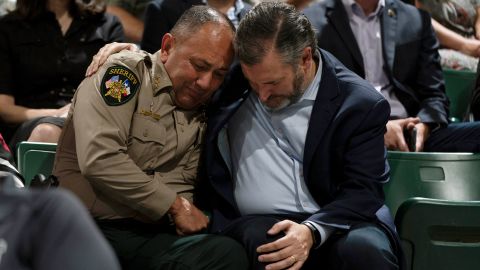
An elected leader answering only to voters, he has not been subject to the same scrutiny as the school police chief – now fired; the acting city police chief – now retired before he could be fired; and members of the Texas Rangers and the Texas Department of Public Safety, who have all faced official scrutiny, leading to suspensions and at least one termination.
CNN has now detailed Nolasco’s actions in our investigation into the leaderless morass and lethal inaction at Uvalde. Nolasco rejected requests for interviews for months. CNN finally caught up with him in November and while he refused to respond to most questions, he did answer when asked if he thought his response was adequate: “Yeah,” he said. “I do.”
The sheriff told an investigator he was at his desk as semiautomatic gunfire first shattered bodies and lives at Robb Elementary School, filling hallways with smoke and prompting a massive law enforcement response. Nolasco left his office to join the operation, he said. But then he diverted to another crime scene.
“I’ve been advised that there’s a woman that’s been shot in the head off of Diaz Street. Woman shot in the head off of Diaz Street by (an) unknown subject,” Nolasco radioed at 11:35 a.m. on May 24 on the sheriff’s office frequency, repeating the information seconds later on the police department channel that was already full of transmissions about shots fired and a gunman jumping a school fence. Why Nolasco changed course toward the woman’s house – and if he could have initiated a lockdown at the school sooner – has been an unanswered question for state investigators. He said later he was alerted to the attack on the woman by a resident who stopped him as he drove past.
At 11:38 a.m., Nolasco was with the victim who remarkably was still conscious and able to speak despite the gunshot wound to her face.
“Who did this to you?” Nolasco can be heard asking on a previously undisclosed recording from a body camera worn by one of his deputies and obtained by CNN. The footage was uploaded to police servers within hours of the shooting and was made available to the Texas Rangers tasked with investigating the response but has not been made public.
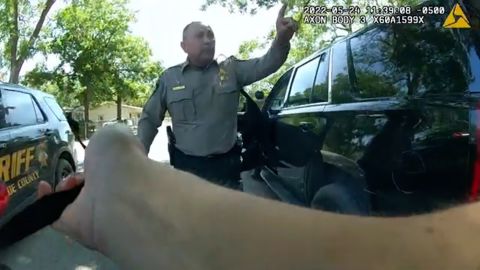
When the female victim said she’d been shot by her grandson, Nolasco asked for and got the gunman’s name.
CNN analysis of radio traffic as well as footage from body-worn and surveillance cameras indicates the name – which CNN is not repeating so as not to fuel his notoriety – was not immediately shared with officers at the school, even as they sought that information through other means.
At 11:43 a.m., a request was made to check the plates of the truck the gunman was driving for a clue to his identity. Eleven minutes later the owner of the vehicle was identified, but it was not the shooter. At 11:59 a.m., school police chief Pedro “Pete” Arredondo tried to start negotiations, but without a name, he could only address the shooter as “Individual in Room 111 and 112.” Any negotiation goes against the post-Columbine policies to immediately take down active shooters.
At 12:08 p.m. – 30 minutes after Nolasco was given the shooter’s name – a sheriff’s deputy in the hallway with Arredondo shared that he had responded to Diaz Street “where (the suspect) shot his first person in the face.” Another man said, “Nobody knows who this guy is.” It is not until 12:37 p.m. that anyone in the hallway outside the classroom is heard using the gunman’s name to address him.
CNN’s review of Nolasco’s actions offers the latest evidence of senior law enforcement officers not taking command or following protocols to stop active shooters and get swift treatment to any victims. At least three of the dead – two children and one teacher – were still alive when officers finally made it into the classroom, well over an hour after the gunman entered.
School police chief Arredondo initially took much of the blame and was fired in August. He said he never considered himself in charge.
Acting Uvalde police chief Lt. Mariano Pargas, who like Nolasco could have taken command, chose to resign after CNN reported that he knew children needed rescuing and did not organize help.
CNN has also revealed the actions and inaction that have seen a Texas Ranger and a state police captain put under review, and a state police sergeant terminated. Another officer who quit the state force while she was under investigation and took a job with the Uvalde school district was fired by that district after CNN showed how she waited outside the school during the attack but said it would have been different if her own son had been inside.
Even though he had the name of a suspect, knew that the man had tried to kill his grandmother, and was less than half a mile from the school, Nolasco chose not to go, instead sending some of his deputies. He stayed with the grandmother as medics arrived, loaded her onto a stretcher and took her to a hospital.
Still at the grandmother’s house, he asked a deputy, “Do they have him surrounded?”
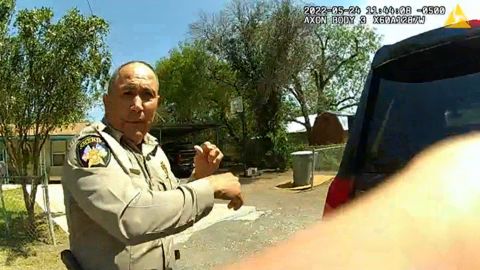
It is not clear if Nolasco knew then that the 18-year-old who had shot his grandmother in the face was also the school shooter. But under questioning by a Texas Ranger, he said, “it’s not going to take a rocket scientist” to connect the two, according to a record of an interview obtained by CNN, which has not been previously reported.
He then headed to the school.
Faced with repeated questions about his response in a recent interview with CNN, Nolasco defended himself and insisted that he wasn’t at the school “for the first 35 minutes, at least the first 35 minutes” of the 77-minute standoff.
He told the investigator he “had a good reason” for the delay, saying he stayed to arrange the EMS transport, persuaded a neighbor to get off the street while the shooter was loose and then made some calls.
But CNN analysis of body cameras shows Nolasco was on scene at the school by 11:49 a.m., just 16 minutes after the gunman went inside.
CNN reached out to Nolasco again about the time of his arrival as shown by the footage but has not heard back.
Once on scene, Nolasco asked one of his deputies, “Where’s the guy at?”
“In a classroom, sheriff,” came the reply. “I don’t know which classroom, but he’s in a classroom.”
Nolasco then said that state police reinforcements from the Texas Department of Public Safety were on their way.
“DPS is coming,” he said. “I got the captain. We need to, we need to get this contained and see what, you know, who’s in charge.”
A text message conversation between Nolasco and DPS Captain Joel Betancourt, obtained by CNN, shows that they were in contact.
At 11:38 a.m., Betancourt texted Nolasco: “Reports of a school shooting in Uvalde. Are they valid?”
“Yes,” replied Nolasco, adding that he was with a woman who has been shot in the head. Betancourt notified him, “On our way.”
Sometime later, Nolasco texted Betancourt, “Barricaded at the school.”
The early and erroneous assessment that the threat was a gunman barricaded by himself, as opposed to an active shooter with victims all around him, was quickly overtaken by events at the school. Officers inside and outside the building soon became aware that classes were in session, that a teacher had called her police officer husband to say she had been shot, and that children were asking 911 for people to come to help them. There was even a burst of gunfire from inside the classroom as responders waited outside.
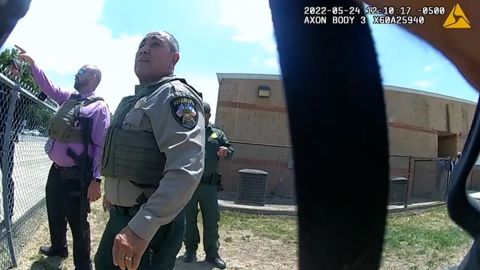
But there was no effective communication that active shooter protocol should be followed – that the threat should be neutralized as quickly as possible – either on the scene or among the many teams, some under DPS leadership, that were heading there. Betancourt told investigators he still believed they were dealing with a “barricaded subject” when he arrived, well into the second hour of the response.
Betancourt also told investigators he spoke with the sheriff for updates while he was driving 60 miles or so from Eagle Pass, Texas, to the school, and that Nolasco told him that the gunman had an AK47. Nolasco denied that, telling CNN, “I never said that.”
The DPS captain himself is under investigation for his actions that day. He told investigators he asked Nolasco while he was driving if he had a command post set up, and again when he arrived as he thought the sheriff was in charge. “I assumed the sheriff was running the show,” he said in one interview.
In a second interview with an investigator, he elaborated, “I know the sheriff has operational control there at the time, and we’re getting with the sheriff to get firsthand information from the incident as it was occurring.”
Nolasco also disputed that to CNN. “It’s his impression, that’s on him. He’s a captain. And if that’s what he assumed, then it was an assumption. It was not validated.”
Betancourt said he did not know school police chief Arredondo was there until later. He did not mention acting city police chief Pargas. DPS also had many of its own officers on scene, including now-fired Sgt. Juan Maldonado who was one of the first to arrive. The department has taken criticism for not taking charge of what its own chief called “an abject failure.” DPS director Col. Steven McCraw told CNN he would resign if his department was culpable but told bereaved families in October he did not think DPS as an institution had failed.
Last month, CNN showed that Pargas had direct knowledge that children and teachers were trapped in classrooms with the gunman when he followed up on a 911 call from a student.
Nolasco complained to an investigator and CNN about how poorly the radios worked in and around the school, and that the noise from helicopters was detrimental too.
Body camera footage, however, shows the radio dispatch of fourth grader Khloie Torres’s call from Room 112 can clearly be heard within earshot of Nolasco, who was outside on the school campus in a small group of law enforcement officers, including a Texas Ranger, talking about what to do.
A Uvalde city police officer reiterated directly to him, “We’ve got a child on the line, 911,” he said. Nolasco did not check whether help was on the way to Khloie, who survived the massacre, and her classmates and teachers and instead focused on evacuating classes not under immediate threat.
He told investigators some classes were cleared.
“We actually found a classroom with some children, and they were OK. But then what we realized is that, hey, this is where the shooter was. He had a clear shot at us. So, we elected to not clear the kids,” he said. “We tell them, ‘Y’all are gonna be OK. Y’all just stay there.’”
Nolasco also spent time outside the school fence as officers tried to keep parents away from the campus. He told one relative of the woman who had been shot on Diaz Street that he had seen her, and she was being taken to a hospital in San Antonio. The woman at the school yelled that the gunman was acting because of some issue with his mother. She cried that her own son was a student at the school. “Just f**king take him out,” she shouted about the gunman. “Kill him, kill him!”
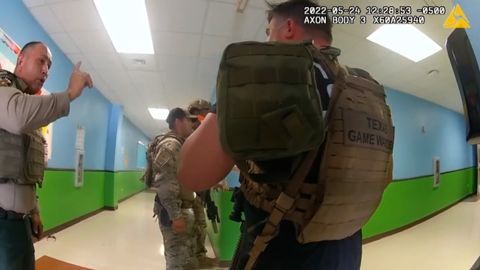
At this time, the school police chief was trying to negotiate with the shooter but still did not have his name. A CNN analysis of footage from inside the school has found no indication that Arredondo was told the gunman had family trouble, even when his identity was known.
Nolasco did enter the school building and headed toward the hallway where officers were ready to shoot the gunman if he came out. He did not address one of his deputies there, but told another nearby officer, a Texas game warden, that there needed to be only one person communicating out from the hallway, and then he left.
The sheriff was with DPS Capt. Betancourt when Betancourt issued an order – that no one heeded – to stop the entry to the classroom that finally killed the gunman at 12:50 p.m.
One of Nolasco’s deputies was in the breach team and fired his weapon at the gunman. Another of his deputies found out that his daughter was among the dead.
In the immediate aftermath of the operation, Nolasco can be seen talking to a Texas Ranger, suggesting the information that children were with the gunman should have slowed things down even further.
“When you have hostages in there, you really don’t want to break down doors,” he said, in direct contradiction of active shooter training for law enforcement, which calls first for officers to neutralize the suspect and “stop the killing,” even if it puts responders or hostages in danger.
A Texas House investigative committee into the Robb massacre said it received information that Nolasco learned about the shooting on Diaz Street by means other than being stopped as he headed toward the school, and perhaps earlier. They requested his phone records to determine whether quicker reporting of the attack on the grandmother could have led to an earlier lockdown at the school or a faster response.
When it issued its report in July, the committee had not received those phone records, though Nolasco told CNN he has now submitted them.
In his post-event interview with investigators, Nolasco said he did not know the exact timings, telling officers to check the logs if they wanted to.
Those are the logs and camera records that CNN has now obtained, and which would also have been available to him.
Nolasco was also emotional and belligerent in his interview nine days after the horrific attack. He called some of the routine questions “insulting” but added, “I know I didn’t do anything wrong. I have nothing to hide.”
After an hour of questions, near the end of the interview, he talked about the suffering of his deputies and said, “It’s been very traumatic for me as well.”
Raising his voice, he cursed and said he needed to vent.
“I’ve had to deal with a lot. It’s bullsh*t that we’re called cowards.”
Source : CNN












